Ablation of Mouse Selenium-Binding Protein 1 and 2 Elevates LDL by Disruption of Cholesterol Efflux and Lipid Metabolism †
Abstract
:1. Introduction
2. Results
2.1. Generation of SeBP1/2-DK Mice and Their Phenotypes
2.2. Deletion of SeBP1/2 Affects β-Oxidation of Fatty Acids in Mice Liver
2.3. Overexpression of hSeBP1 in HepG2 Promotes β-Oxidation of Fatty Acids
2.4. Knockout of SeBP1/2 Inhibits Cholesterol Transport from the Liver but Has No Effect on Cholesterol Synthesis in Mice
2.5. SeBP1 and SeBP2 Are Positive Regulators of Superoxide Dismutase In Vivo and In Vitro
3. Discussion
4. Materials and Methods
4.1. Construction of SeBP1/2 Knockout Mice
4.2. Cell Culture and Transfection
4.3. Cell Viability Assay
4.4. Western Blot Analysis
4.5. Biochemical Analysis
4.6. Lipid Peroxidation
4.7. Histopathology
4.8. Real-Time Quantitative Reverse Transcription PCR (qRT-PCR)
4.9. Statistical Analysis
Supplementary Materials
Author Contributions
Funding
Institutional Review Board Statement
Informed Consent Statement
Data Availability Statement
Acknowledgments
Conflicts of Interest
Abbreviations
| SeBP1 | selenium-binding protein 1 |
| SeBP2 | selenium-binding protein 2 |
| SeBP1/2-DK | SeBP1 and SeBP2 double-knockout mice |
| PPARA | peroxisome proliferator-activated receptor-alpha |
| hSeBP1 | human selenium-binding protein 1 |
| NEFA | non-esterified fatty acids |
| TG | triglyceride |
| HDL-C | high-density lipoprotein cholesterol |
| LDL-C | low-density lipoprotein cholesterol |
| TCDD | 2,3,7,8-tetrachlorodibenzo-p-dioxin |
| SeBP1-SK | SeBP1 single knockout mice |
| AST | aspartate aminotransferase |
| ALT | alanine aminotransferase |
| Rxra | retinoid X receptor alpha |
| Acox1 | acyl-CoA oxidase 1 |
| Acox3 | acyl-CoA oxidase 3 |
| Cpt1a | carnitine palmitoyl transferase 1A |
| Cpt2 | carnitine palmitoyl transferase 2 |
| Cyp4a12a | cytochrome P450, family 4, subfamily a, polypeptide 12A |
| Cyp4a12b | cytochrome P450, family 4, subfamily a, polypeptide 12B |
| Acaca | acetyl-coA carboxylase alpha 1 |
| Fasn | fatty acid synthase |
| Srebp1 | sterol regulatory element-binding protein 1 |
| Pparg | peroxisome proliferator-activated receptor gamma |
| Hmgcr | 3-hydroxy-3-methylglutaryl-CoA reductase |
| Srebp2 | sterol regulatory element-binding protein 2 |
| Lxra | liver X receptor alpha |
| Abca1 | ATP-binding cassette transporter A1 |
| Abcg1 | ATP-binding cassette transporter G1 |
| Abcg5 | ATP-binding cassette transporter G5 |
| Abcg8 | ATP-binding cassette transporter G8 |
| Npc1l1 | Niemann–Pick c1-like 1 |
| MDA | malondialdehyde |
| SOD | superoxide dismutase |
| H2O2 | hydrogen peroxide |
References
- Handy, D.E.; Joseph, J.; Loscalzo, J. Selenium, a Micronutrient That Modulates Cardiovascular Health via Redox Enzymology. Nutrients 2021, 13, 3238. [Google Scholar] [CrossRef] [PubMed]
- An, P.; Wan, S.; Luo, Y.; Luo, J.; Zhang, X.; Zhou, S.; Xu, T.; He, J.; Mechanick, J.I.; Wu, W.C.; et al. Micronutrient Supplementation to Reduce Cardiovascular Risk. J. Am. Coll. Cardiol. 2022, 80, 2269–2285. [Google Scholar] [CrossRef] [PubMed]
- Hariharan, S.; Dharmaraj, S. Selenium and selenoproteins: It’s role in regulation of inflammation. Inflammopharmacology 2020, 28, 667–695. [Google Scholar] [CrossRef] [PubMed]
- de Andrade, K.Q.; Moura, F.A.; dos Santos, J.M.; de Araújo, O.R.; de Farias Santos, J.C.; Goulart, M.O. Oxidative Stress and Inflammation in Hepatic Diseases: Therapeutic Possibilities of N-Acetylcysteine. Int. J. Mol. Sci. 2015, 16, 30269–30308. [Google Scholar] [CrossRef]
- Vinceti, M.; Filippini, T.; Del Giovane, C.; Dennert, G.; Zwahlen, M.; Brinkman, M.; Zeegers, M.P.; Horneber, M.; D’Amico, R.; Crespi, C.M. Selenium for preventing cancer. Cochrane Database Syst. Rev. 2018, 1, CD005195. [Google Scholar] [CrossRef]
- Kryukov, G.V.; Castellano, S.; Novoselov, S.V.; Lobanov, A.V.; Zehtab, O.; Guigó, R.; Gladyshev, V.N. Characterization of mammalian selenoproteomes. Science 2003, 300, 1439–1443. [Google Scholar] [CrossRef]
- Gladyshev, V.N.; Arnér, E.S.; Berry, M.J.; Brigelius-Flohé, R.; Bruford, E.A.; Burk, R.F.; Carlson, B.A.; Castellano, S.; Chavatte, L.; Conrad, M.; et al. Selenoprotein Gene Nomenclature. J. Biol. Chem. 2016, 291, 24036–24040. [Google Scholar] [CrossRef]
- Bansal, M.P.; Oborn, C.J.; Danielson, K.G.; Medina, D. Evidence for two selenium-binding proteins distinct from glutathione peroxidase in mouse liver. Carcinogenesis 1989, 10, 541–546. [Google Scholar] [CrossRef]
- Bansal, M.P.; Mukhopadhyay, T.; Scott, J.; Cook, R.G.; Mukhopadhyay, R.; Medina, D. DNA sequencing of a mouse liver protein that binds selenium: Implications for selenium’s mechanism of action in cancer prevention. Carcinogenesis 1990, 11, 2071–2073. [Google Scholar] [CrossRef]
- Ogasawara, Y.; Lacourciere, G.M.; Ishii, K.; Stadtman, T.C. Characterization of potential selenium-binding proteins in the selenophosphate synthetase system. Proc. Natl. Acad. Sci. USA 2005, 102, 1012–1016. [Google Scholar] [CrossRef]
- Wang, Y.; Fang, W.; Huang, Y.; Hu, F.; Ying, Q.; Yang, W.; Xiong, B. Reduction of selenium-binding protein 1 sensitizes cancer cells to selenite via elevating extracellular glutathione: A novel mechanism of cancer-specific cytotoxicity of selenite. Free Radic. Biol. Med. 2015, 79, 186–196. [Google Scholar] [CrossRef] [PubMed]
- Fang, W.; Goldberg, M.L.; Pohl, N.M.; Bi, X.; Tong, C.; Xiong, B.; Koh, T.J.; Diamond, A.M.; Yang, W. Functional and physical interaction between the selenium-binding protein 1 (SBP1) and the glutathione peroxidase 1 selenoprotein. Carcinogenesis 2010, 31, 1360–1366. [Google Scholar] [CrossRef] [PubMed]
- Zhao, W.; Nikolic-Paterson, D.J.; Li, K.; Li, Y.; Wang, Y.; Chen, X.; Duan, Z.; Zhang, Y.; Liu, P.; Lu, S.; et al. Selenium binding protein 1 protects renal tubular epithelial cells from ferroptosis by upregulating glutathione peroxidase 4. Chem. Biol. Interact. 2024, 393, 110944. [Google Scholar] [CrossRef] [PubMed]
- Chen, G.; Wang, H.; Miller, C.T.; Thomas, D.G.; Gharib, T.G.; Misek, D.E.; Giordano, T.J.; Orringer, M.B.; Hanash, S.M.; Beer, D.G. Reduced selenium-binding protein 1 expression is associated with poor outcome in lung adenocarcinomas. J. Pathol. 2004, 202, 321–329. [Google Scholar] [CrossRef]
- Zhu, Y.; Pu, Q.; Zhang, Q.; Liu, Y.; Ma, Y.; Yuan, Y.; Liu, L.; Zhu, W. Selenium-binding protein 1 inhibits malignant progression and induces apoptosis via distinct mechanisms in non-small cell lung cancer. Cancer Med. 2023, 12, 17149–17170. [Google Scholar] [CrossRef]
- Wang, Y.; Zhu, W.; Chen, X.; Wei, G.; Jiang, G.; Zhang, G. Selenium-binding protein 1 transcriptionally activates p21 expression via p53-independent mechanism and its frequent reduction associates with poor prognosis in bladder cancer. J. Transl. Med. 2020, 18, 17. [Google Scholar] [CrossRef]
- Ma, J.; Huang, X.; Xu, J.; Li, Z.; Lai, J.; Shen, Y.; Zhao, J.; Sun, X.; Ma, L. SBP1 promotes tumorigenesis of thyroid cancer through TXN/NIS pathway. Mol. Med. 2023, 29, 121. [Google Scholar] [CrossRef]
- Tsujimoto, S.; Ishida, T.; Takeda, T.; Ishii, Y.; Onomura, Y.; Tsukimori, K.; Takechi, S.; Yamaguchi, T.; Uchi, H.; Suzuki, S.O.; et al. Selenium-binding protein 1: Its physiological function, dependence on aryl hydrocarbon receptors, and role in wasting syndrome by 2,3,7,8-tetrachlorodibenzo-p-dioxin. Biochim. Biophys. Acta 2013, 1830, 3616–3624. [Google Scholar] [CrossRef]
- Ishii, Y.; Hatsumura, M.; Ishida, T.; Ariyoshi, N.; Oguri, K. Significant induction of a 54-kDa protein in rat liver with homologous alignment to mouse selenium binding protein by a coplanar polychlorinated biphenyl, 3,4,5,3′,4′-pentachlorobiphenyl and 3-methylcholanthrene. Toxicol. Lett. 1996, 87, 1–9. [Google Scholar] [CrossRef]
- Lanfear, J.; Fleming, J.; Walker, M.; Harrison, P. Different patterns of regulation of the genes encoding the closely related 56 kDa selenium- and acetaminophen-binding proteins in normal tissues and during carcinogenesis. Carcinogenesis 1993, 14, 335–340. [Google Scholar] [CrossRef]
- Song, Y.; Kurose, A.; Li, R.; Takeda, T.; Onomura, Y.; Koga, T.; Mutoh, J.; Ishida, T.; Tanaka, Y.; Ishii, Y. Ablation of Selenbp1 Alters Lipid Metabolism via the Pparα Pathway in Mouse Kidney. Int. J. Mol. Sci. 2021, 22, 5334. [Google Scholar] [CrossRef] [PubMed]
- Bardot, O.; Aldridge, T.C.; Latruffe, N.; Green, S. PPAR-RXR heterodimer activates a peroxisome proliferator response element upstream of the bifunctional enzyme gene. Biochem. Biophys. Res. Commun. 1993, 192, 37–45. [Google Scholar] [CrossRef] [PubMed]
- Castaño, C.; Kalko, S.; Novials, A.; Párrizas, M. Obesity-associated exosomal miRNAs modulate glucose and lipid metabolism in mice. Proc. Natl. Acad. Sci. USA 2018, 115, 12158–12163. [Google Scholar] [CrossRef]
- Li, L.; Zhou, J.; Wang, S.; Jiang, L.; Chen, X.; Zhou, Y.; Li, J.; Shi, J.; Liu, P.; Shu, Z.; et al. Critical role of peroxisome proliferator-activated receptor α in promoting platelet hyperreactivity and thrombosis under hyperlipidemia. Haematologica 2022, 107, 1358–1373. [Google Scholar] [CrossRef]
- Tao, H.; Yancey, P.G.; Blakemore, J.L.; Zhang, Y.; Ding, L.; Jerome, W.G.; Brown, J.D.; Vickers, K.C.; Linton, M.F. Macrophage SR-BI modulates autophagy via VPS34 complex and PPARα transcription of Tfeb in atherosclerosis. J. Clin. Investig. 2021, 131, e94229. [Google Scholar] [CrossRef]
- Pol, A.; Renkema, G.H.; Tangerman, A.; Winkel, E.G.; Engelke, U.F.; de Brouwer, A.P.M.; Lloyd, K.C.; Araiza, R.S.; van den Heuvel, L.; Omran, H.; et al. Mutations in SELENBP1, encoding a novel human methanethiol oxidase, cause extraoral halitosis. Nat. Genet. 2018, 50, 120–129. [Google Scholar] [CrossRef]
- Philipp, T.M.; Gernoth, L.; Will, A.; Schwarz, M.; Ohse, V.A.; Kipp, A.P.; Steinbrenner, H.; Klotz, L.O. Selenium-binding protein 1 (SELENBP1) is a copper-dependent thiol oxidase. Redox Biol. 2023, 65, 102807. [Google Scholar] [CrossRef]
- Steinbrenner, H.; Micoogullari, M.; Hoang, N.A.; Bergheim, I.; Klotz, L.O.; Sies, H. Selenium-binding protein 1 (SELENBP1) is a marker of mature adipocytes. Redox Biol. 2019, 20, 489–495. [Google Scholar] [CrossRef]
- Karmen, A.; Wroblewski, F.; Ladue, J.S. Transaminase activity in human blood. J. Clin. Investig. 1955, 34, 126–131. [Google Scholar] [CrossRef]
- Li, B.; Ming, H.; Qin, S.; Nice, E.C.; Dong, J.; Du, Z.; Huang, C. Redox regulation: Mechanisms, biology and therapeutic targets in diseases. Signal Transduct. Target. Ther. 2025, 10, 72. [Google Scholar] [CrossRef]
- Kamijo, Y.; Hora, K.; Kono, K.; Takahashi, K.; Higuchi, M.; Ehara, T.; Kiyosawa, K.; Shigematsu, H.; Gonzalez, F.J.; Aoyama, T. PPARalpha protects proximal tubular cells from acute fatty acid toxicity. J. Am. Soc. Nephrol. 2007, 18, 3089–3100. [Google Scholar] [CrossRef] [PubMed]
- Zhao, S.; Nakashima, Y.; Song, Y.; Li, R.S.; Koga, T.; Tanaka, Y.; Ishii, Y. Selenium-binding protein (SeBP)1/2 modulate hepatic lipid metabolism through PPARα: Study using SeBP1/2-double knockout mice. In Proceedings of the Abstracts of papers, 144th Annual Meeting of the Pharmaceutical Society of Japan, Yokohama, Japan, 28–31 March 2024. [Google Scholar]
- Marston, N.A.; Giugliano, R.P.; Melloni, G.E.M.; Park, J.G.; Morrill, V.; Blazing, M.A.; Ference, B.; Stein, E.; Stroes, E.S.; Braunwald, E.; et al. Association of Apolipoprotein B-Containing Lipoproteins and Risk of Myocardial Infarction in Individuals With and Without Atherosclerosis: Distinguishing Between Particle Concentration, Type, and Content. JAMA Cardiol. 2022, 7, 250–256. [Google Scholar] [CrossRef] [PubMed]
- Song, G.; Li, M.; Sang, H.; Zhang, L.; Li, X.; Yao, S.; Yu, Y.; Zong, C.; Xue, Y.; Qin, S. Hydrogen-rich water decreases serum LDL-cholesterol levels and improves HDL function in patients with potential metabolic syndrome. J. Lipid Res. 2013, 54, 1884–1893. [Google Scholar] [CrossRef]
- Schober, G.; Arnold, M.; Birtles, S.; Buckett, L.K.; Pacheco-López, G.; Turnbull, A.V.; Langhans, W.; Mansouri, A. Diacylglycerol acyltransferase-1 inhibition enhances intestinal fatty acid oxidation and reduces energy intake in rats. J. Lipid Res. 2013, 54, 1369–1384. [Google Scholar] [CrossRef]
- Bonnefont, J.P.; Djouadi, F.; Prip-Buus, C.; Gobin, S.; Munnich, A.; Bastin, J. Carnitine palmitoyltransferases 1 and 2: Biochemical, molecular and medical aspects. Mol. Asp. Med. 2004, 25, 495–520. [Google Scholar] [CrossRef]
- Varanasi, U.; Chu, R.; Chu, S.; Espinosa, R.; LeBeau, M.M.; Reddy, J.K. Isolation of the human peroxisomal acyl-CoA oxidase gene: Organization, promoter analysis, and chromosomal localization. Proc. Natl. Acad. Sci. USA 1994, 91, 3107–3111. [Google Scholar] [CrossRef]
- Gatica, A.; Aguilera, M.C.; Contador, D.; Loyola, G.; Pinto, C.O.; Amigo, L.; Tichauer, J.E.; Zanlungo, S.; Bronfman, M. P450 CYP2C epoxygenase and CYP4A omega-hydroxylase mediate ciprofibrate-induced PPARalpha-dependent peroxisomal proliferation. J. Lipid Res. 2007, 48, 924–934. [Google Scholar] [CrossRef]
- Lékó, A.H.; Gregory-Flores, A.; Marchette, R.C.N.; Gomez, J.L.; Vendruscolo, J.C.M.; Repunte-Canonigo, V.; Choung, V.; Deschaine, S.L.; Whiting, K.E.; Jackson, S.N.; et al. Genetic or pharmacological GHSR blockade has sexually dimorphic effects in rodents on a high-fat diet. Commun Biol. 2024, 7, 632. [Google Scholar] [CrossRef]
- Zhao, S.; Nakashima, Y.; Song, Y.; Li, R.S.; Koga, T.; Tanaka, Y.; Ishii, Y. Role of human selenium-binding protein 1 in lipid metabolism with HepG2. In Proceedings of the Abstracts of papers, Forum 2023: Pharmaceutical Health Science-Environmental Toxicology, the Pharmaceutical Society of Japan, Hiroshima, Japan, September 2023. [Google Scholar]
- Huang, C.; Ding, G.; Gu, C.; Zhou, J.; Kuang, M.; Ji, Y.; He, Y.; Kondo, T.; Fan, J. Decreased selenium-binding protein 1 enhances glutathione peroxidase 1 activity and downregulates HIF-1α to promote hepatocellular carcinoma invasiveness. Clin. Cancer Res. 2012, 18, 3042–3053. [Google Scholar] [CrossRef]
- Zhang, X.; Li, S.; Zhou, Y.; Su, W.; Ruan, X.; Wang, B.; Zheng, F.; Warner, M.; Gustafsson, J.Å.; Guan, Y. Ablation of cytochrome P450 omega-hydroxylase 4A14 gene attenuates hepatic steatosis and fibrosis. Proc. Natl. Acad. Sci. USA 2017, 114, 3181–3185. [Google Scholar] [CrossRef]
- Hardwick J., P. Cytochrome P450 omega hydroxylase (CYP4) function in fatty acid metabolism and metabolic diseases. Biochem Pharmacol. 2008, 75, 2263–2275. [Google Scholar] [CrossRef] [PubMed]
- Lock, E.A.; Mitchell, A.M.; Elcombe, C.R. Biochemical mechanisms of induction of hepatic peroxisome proliferation. Annu. Rev. Pharmacol. Toxicol. 1989, 29, 145–163. [Google Scholar] [CrossRef] [PubMed]
- Gao, Y.; Sun, Y.Y.; Bai, D.; Wu, X.X. Mechanism of the components compatibility of Scutellariae Radix and Coptidis Rhizoma on mice with hyperlipidemia by regulating the Cyp4a family. J. Ethnopharmacol. 2024, 331, 118263. [Google Scholar] [CrossRef] [PubMed]
- Hanahan, D. Hallmarks of Cancer: New Dimensions. Cancer Discov. 2022, 12, 31–46. [Google Scholar] [CrossRef]
- Singh, V.; Jain, M.; Misra, A.; Khanna, V.; Rana, M.; Prakash, P.; Malasoni, R.; Dwivedi, A.K.; Dikshit, M.; Barthwal, M.K. Curcuma oil ameliorates hyperlipidaemia and associated deleterious effects in golden Syrian hamsters. Br. J. Nutr. 2013, 110, 437–446. [Google Scholar] [CrossRef]
- Berge, K.E.; Tian, H.; Graf, G.A.; Yu, L.; Grishin, N.V.; Schultz, J.; Kwiterovich, P.; Shan, B.; Barnes, R.; Hobbs, H.H. Accumulation of dietary cholesterol in sitosterolemia caused by mutations in adjacent ABC transporters. Science 2000, 290, 1771–1775. [Google Scholar] [CrossRef]
- Uehara, Y.; Miura, S.; von Eckardstein, A.; Abe, S.; Fujii, A.; Matsuo, Y.; Rust, S.; Lorkowski, S.; Assmann, G.; Yamada, T.; et al. Unsaturated fatty acids suppress the expression of the ATP-binding cassette transporter G1 (ABCG1) and ABCA1 genes via an LXR/RXR responsive element. Atherosclerosis 2007, 191, 11–21. [Google Scholar] [CrossRef]
- Chen, Y.; Zhao, Y.F.; Yang, J.; Jing, H.Y.; Liang, W.; Chen, M.Y.; Yang, M.; Wang, Y.; Guo, M.Y. Selenium alleviates lipopolysaccharide-induced endometritis via regulating the recruitment of TLR4 into lipid rafts in mice. Food Funct. 2020, 11, 200–210. [Google Scholar] [CrossRef]
- Chinetti, G.; Lestavel, S.; Bocher, V.; Remaley, A.T.; Neve, B.; Torra, I.P.; Teissier, E.; Minnich, A.; Jaye, M.; Duverger, N.; et al. PPAR-alpha and PPAR-gamma activators induce cholesterol removal from human macrophage foam cells through stimulation of the ABCA1 pathway. Nat. Med. 2001, 7, 53–58. [Google Scholar] [CrossRef]
- Napolitano, M.; Blotta, I.; Montali, A.; Bravo, E. 17beta-estradiol enhances the flux of cholesterol through the cholesteryl ester cycle in human macrophages. Biosci Rep. 2001, 21, 637–652. [Google Scholar] [CrossRef]
- Holven, K.B.; Roeters van Lennep, J. Sex differences in lipids: A life course approach. Atherosclerosis 2023, 384, 117270. [Google Scholar] [CrossRef] [PubMed]
- Mccord, J.M.; Fridovich, I. Superoxide dismutase. An enzymic function for erythrocuprein (hemocuprein). J. Biol. Chem. 1969, 244, 6049–6055. [Google Scholar] [CrossRef] [PubMed]
- Fu, B.; Wang, J.; Wang, L.; Wang, Q.; Guo, Z.; Xu, M.; Jiang, N. Integrated proteomic and metabolomic profile analyses of cardiac valves revealed molecular mechanisms and targets in calcific aortic valve disease. Front. Cardiovasc. Med. 2022, 9, 944521. [Google Scholar] [CrossRef]
- Lowry, O.H.; Rosebrough, N.J.; Farr, A.L.; Randall, R.J. Protein measurement with the Folin phenol reagent. J. Biol. Chem. 1951, 193, 265–275. [Google Scholar]
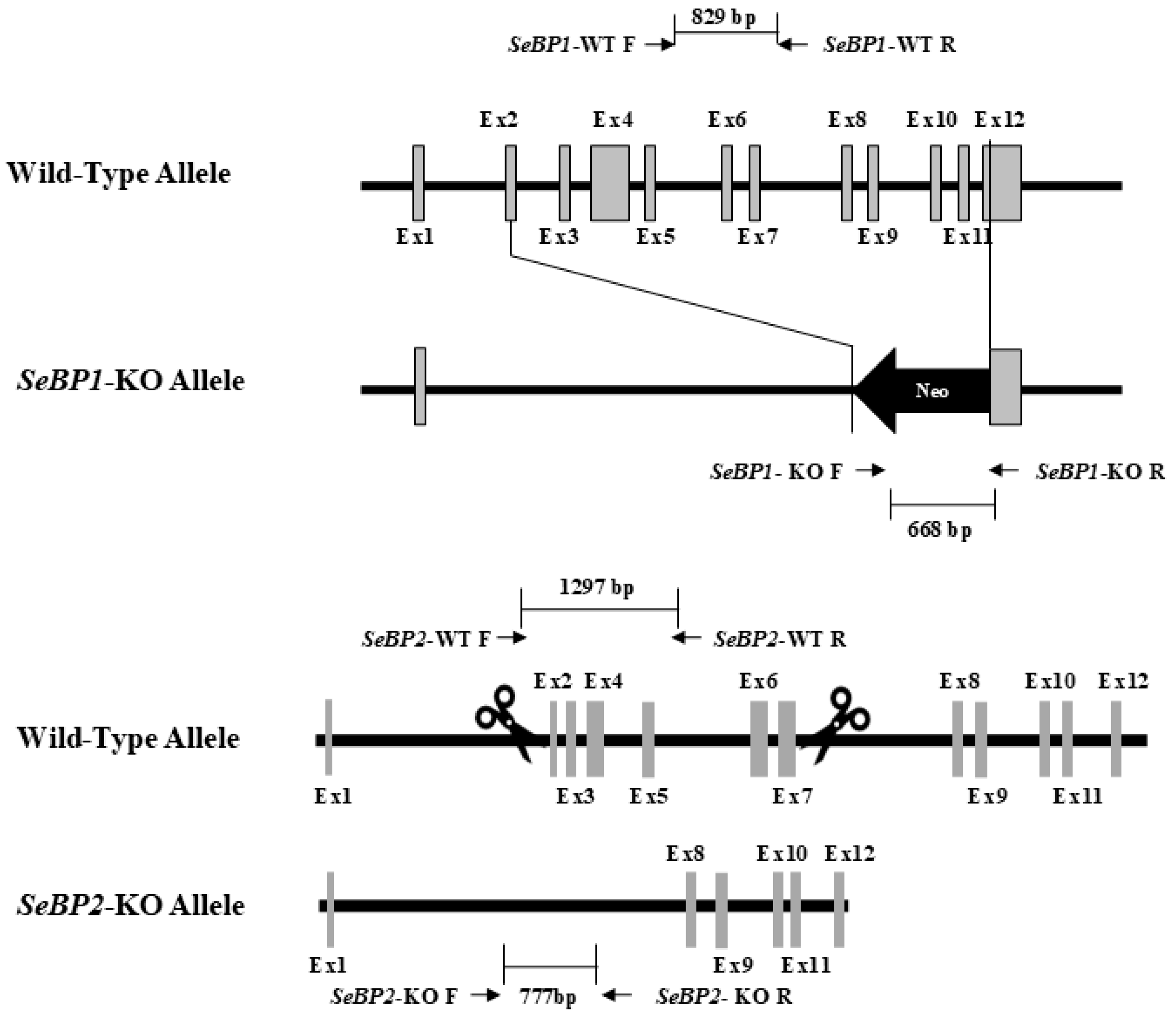
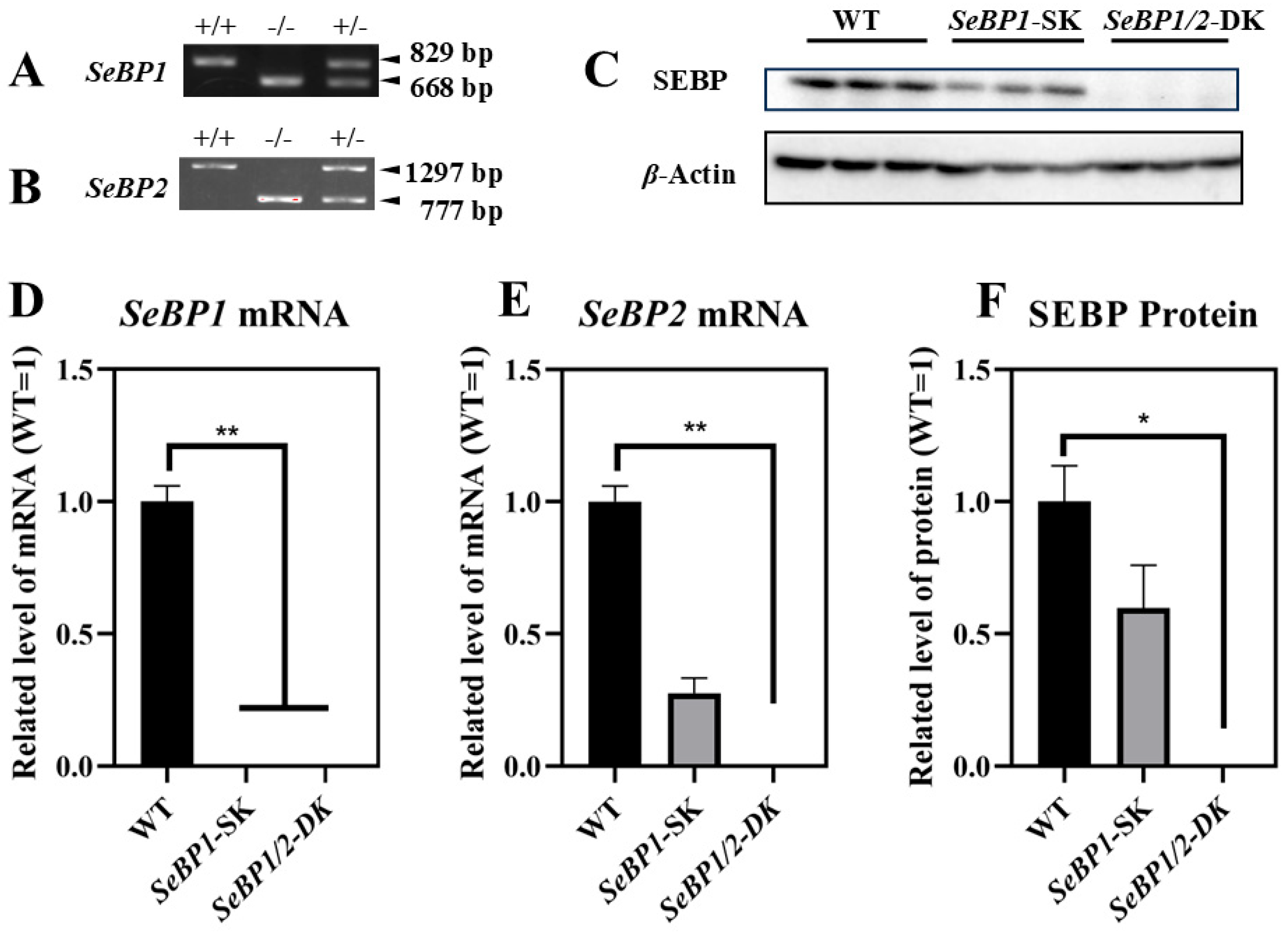



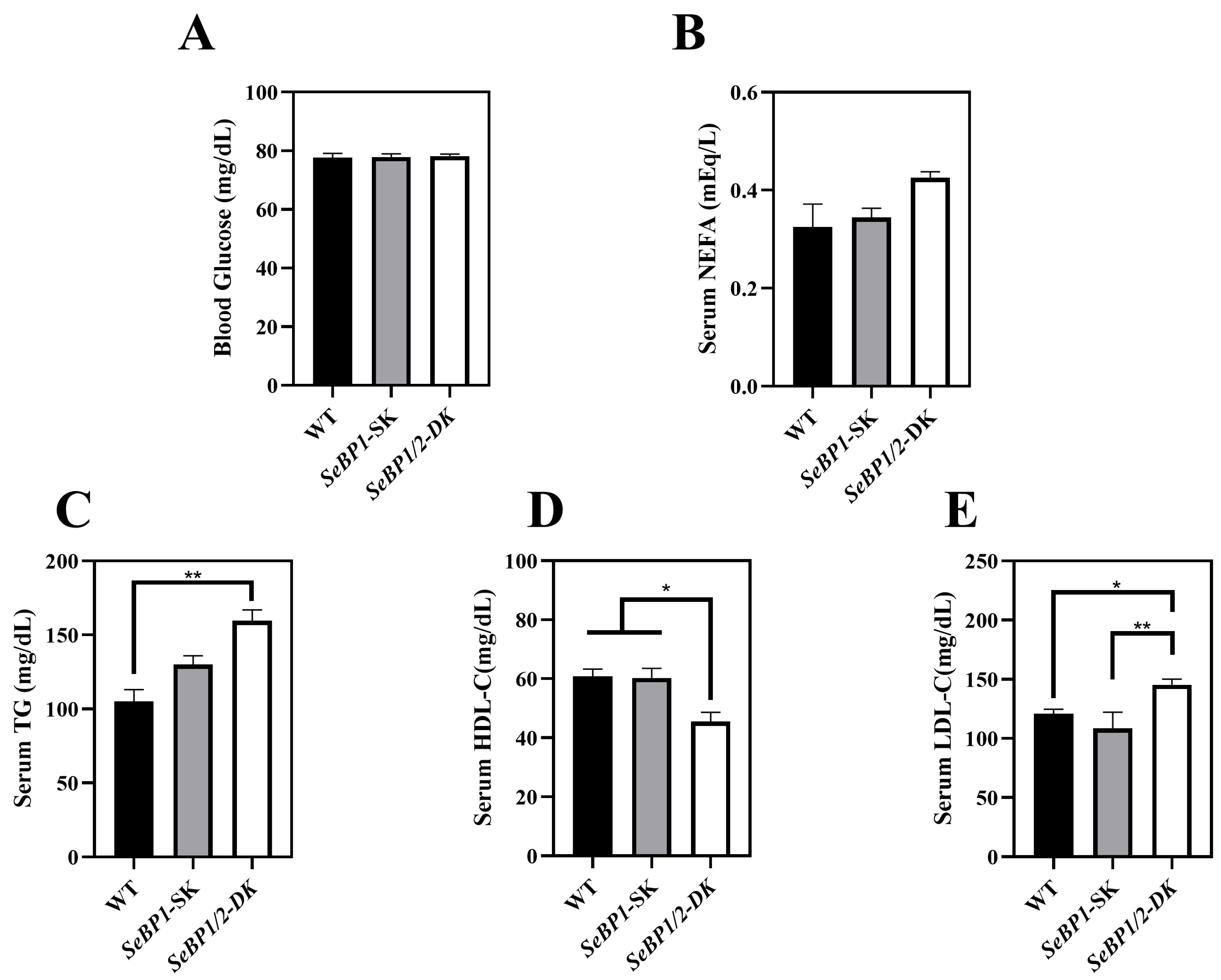
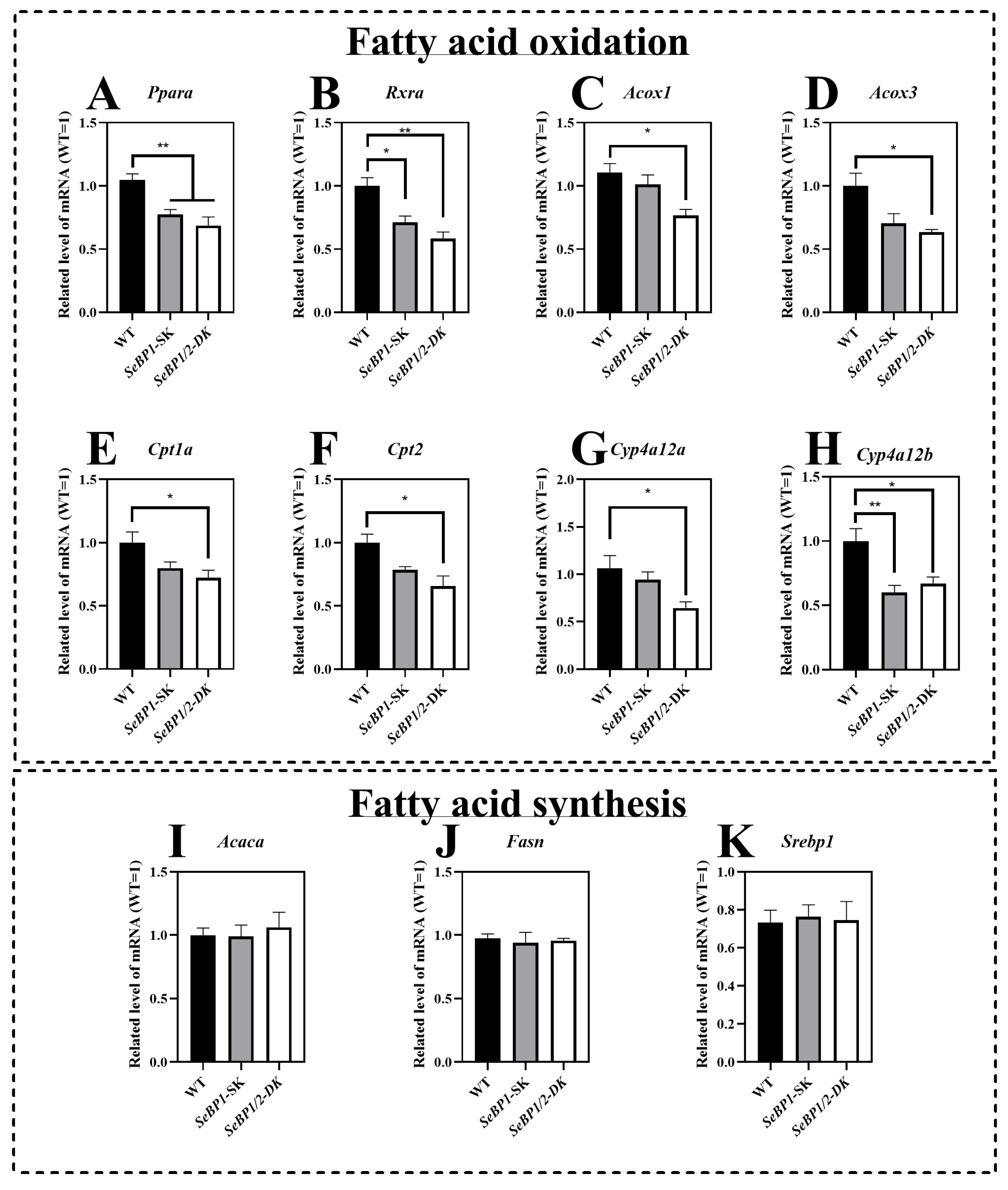
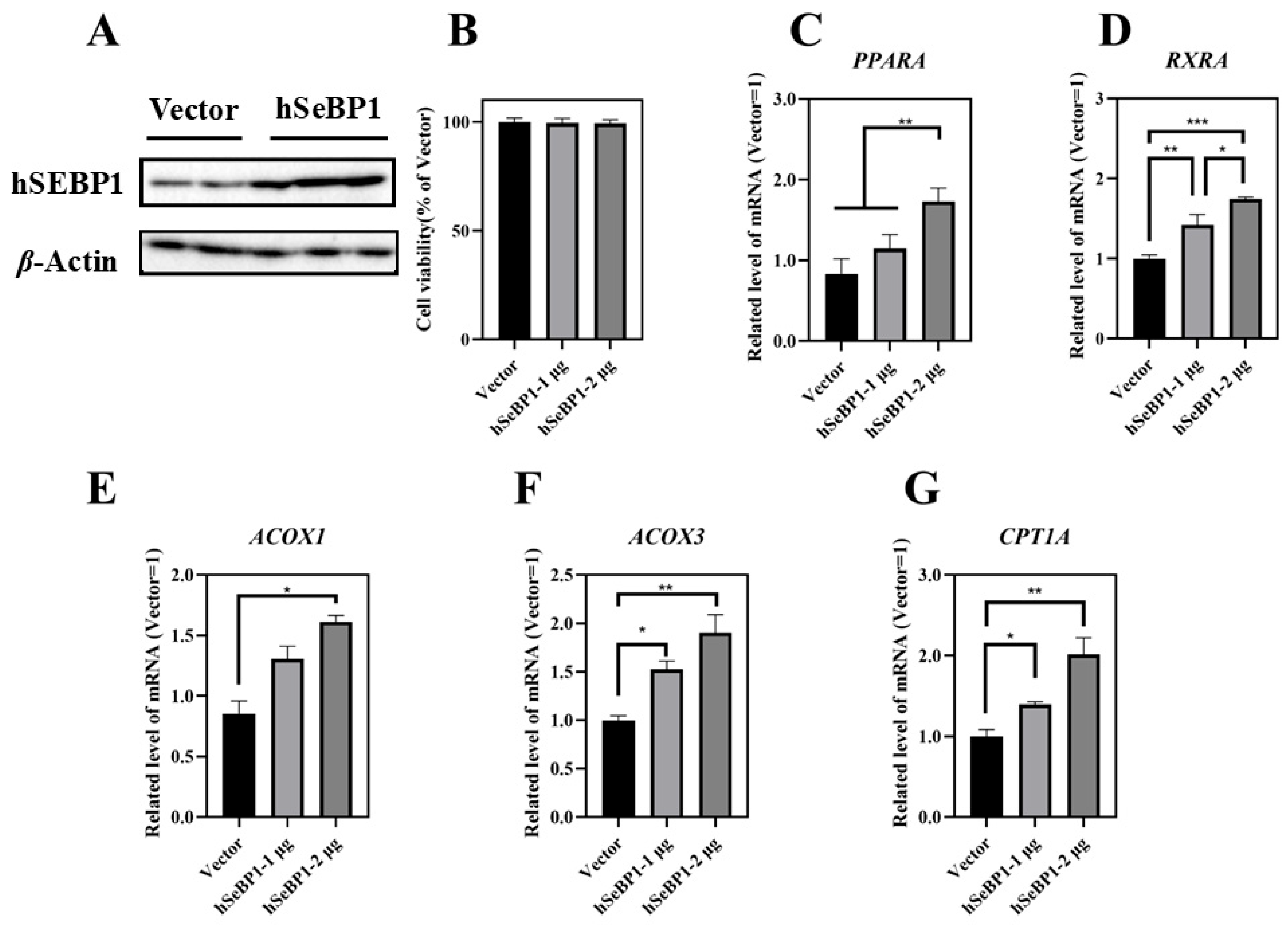
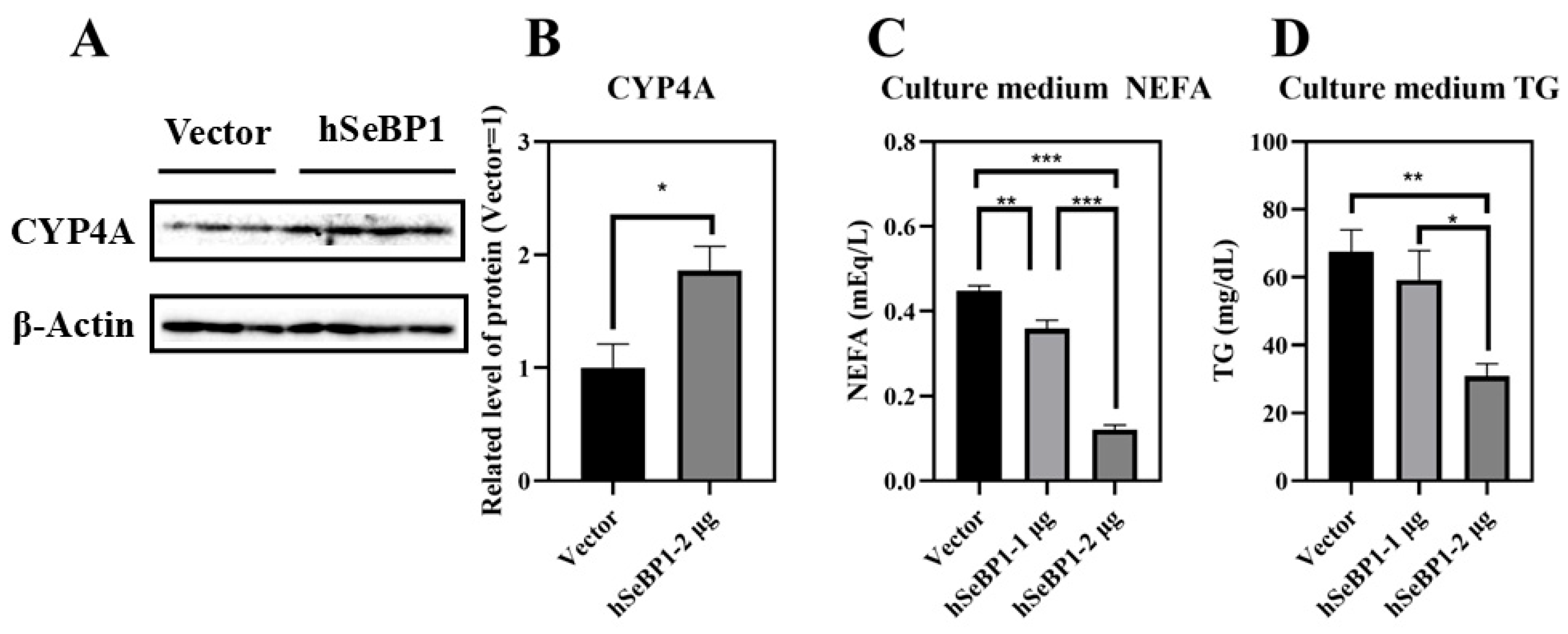


| Tissue | Male (N = 9) | Female (N = 7) | ||||
|---|---|---|---|---|---|---|
| WT | SeBP1-SK | SeBP1/2-DK | WT | SeBP1-SK | SeBP1/2-DK | |
| Liver | 4.73 ± 0.18 | 4.29 ± 0.19 * | 4.18 ± 0.20 * | 4.61 ± 0.11 | 4.48 ± 0.13 | 4.33 ± 0.12 |
| Kidney | 0.72 ± 0.04 | 0.69 ± 0.03 | 0.68 ± 0.03 | 0.69 ± 0.02 | 0.70 ± 0.02 | 0.72 ± 0.02 |
| Lung | 0.60 ± 0.01 | 0.61 ± 0.01 | 0.64 ± 0.01 | 0.76 ± 0.04 | 0.72 ± 0.02 | 0.70 ± 0.03 |
| Heart | 0.53 ± 0.03 | 0.50 ± 0.03 | 0.48 ± 0.03 | 0.57 ± 0.01 | 0.55 ± 0.02 | 0.55 ± 0.02 |
| Brain | 1.27 ± 0.01 | 1.26 ± 0.01 | 1.28 ± 0.02 | 1.75 ± 0.03 | 1.79 ± 0.04 | 1.78 ± 0.02 |
| Spleen | 0.37 ± 0.01 | 0.35 ± 0.01 | 0.34 ± 0.01 | 0.44 ± 0.02 | 0.43 ± 0.01 | 0.46 ± 0.01 |
| Gonad a | 0.55 ± 0.01 | 0.54 ± 0.01 | 0.54 ± 0.01 | 0.02 ± 0.00 b | 0.02 ± 0.00 b | 0.02 ± 0.00 b |
| eWAT | 3.18 ± 0.02 | 3.21 ± 0.01 | 3.26 ± 0.01 | |||
Disclaimer/Publisher’s Note: The statements, opinions and data contained in all publications are solely those of the individual author(s) and contributor(s) and not of MDPI and/or the editor(s). MDPI and/or the editor(s) disclaim responsibility for any injury to people or property resulting from any ideas, methods, instructions or products referred to in the content. |
© 2025 by the authors. Licensee MDPI, Basel, Switzerland. This article is an open access article distributed under the terms and conditions of the Creative Commons Attribution (CC BY) license (https://creativecommons.org/licenses/by/4.0/).
Share and Cite
Zhao, S.; Song, Y.; Nakashima, Y.; Zou, X.; Koga, T.; Ishida, T.; Li, R.; Hirota, Y.; Tanaka, Y.; Ishii, Y. Ablation of Mouse Selenium-Binding Protein 1 and 2 Elevates LDL by Disruption of Cholesterol Efflux and Lipid Metabolism. Int. J. Mol. Sci. 2025, 26, 3363. https://doi.org/10.3390/ijms26073363
Zhao S, Song Y, Nakashima Y, Zou X, Koga T, Ishida T, Li R, Hirota Y, Tanaka Y, Ishii Y. Ablation of Mouse Selenium-Binding Protein 1 and 2 Elevates LDL by Disruption of Cholesterol Efflux and Lipid Metabolism. International Journal of Molecular Sciences. 2025; 26(7):3363. https://doi.org/10.3390/ijms26073363
Chicago/Turabian StyleZhao, Shuangli, Yingxia Song, Yuko Nakashima, Xing Zou, Takayuki Koga, Takumi Ishida, Renshi Li, Yuko Hirota, Yoshitaka Tanaka, and Yuji Ishii. 2025. "Ablation of Mouse Selenium-Binding Protein 1 and 2 Elevates LDL by Disruption of Cholesterol Efflux and Lipid Metabolism" International Journal of Molecular Sciences 26, no. 7: 3363. https://doi.org/10.3390/ijms26073363
APA StyleZhao, S., Song, Y., Nakashima, Y., Zou, X., Koga, T., Ishida, T., Li, R., Hirota, Y., Tanaka, Y., & Ishii, Y. (2025). Ablation of Mouse Selenium-Binding Protein 1 and 2 Elevates LDL by Disruption of Cholesterol Efflux and Lipid Metabolism. International Journal of Molecular Sciences, 26(7), 3363. https://doi.org/10.3390/ijms26073363






